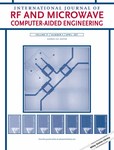Broadband substrate-integrated waveguide-fed endfire metasurface antenna array with gain enhancement
This work was supported by the National Natural Foundation of China under Grant 61871394.
Funding information: The National Natural Foundation of China, Grant/Award Number: 61871394
Abstract
A broadband substrate-integrated waveguide (SIW)-fed endfire metasurface antenna array with improved gain centralisation radiation pattern is proposed in this paper. The metasurface is composed of 3 × 3 rectangular patches distributed on both the upper and lower sides of a single-layer substrate. For wideband endfire radiation, an open-end SIW on the metasurface side feeds the antenna. To improve front to back radiation and ration matching characteristics, one C-shaped slot is etched on the top surface of SIW. Two L-shaped metal walls composed of metalized via holes are employed to centralize radiation pattern and reduce both the side lobe and back lobe levels. In addition, the gain of the antenna is enhanced more than 1.6 dBi. To validate this design, a 1 × 8 uniform excitation array is proposed and fabricated, containing three SIW T junctions and four Y junctions. The whole dimension is 7.33λ0× 3.82λ0 × 0.06λ0. Measurement results imply that an 7.5 to 13.05 GHz (54%) impedance bandwidth can be achieved with the maximum gain of 14.9 dBi.
Open Research
DATA AVAILABILITY STATEMENT
Data sharing not applicable to this article as no datasets were generated or analysed during the current study




